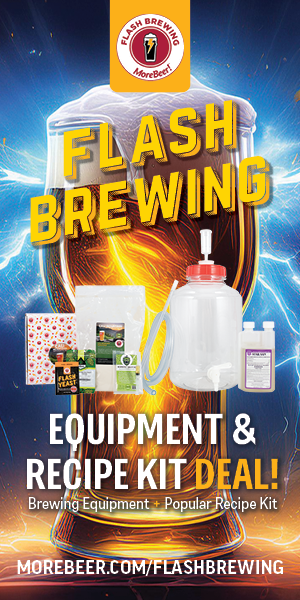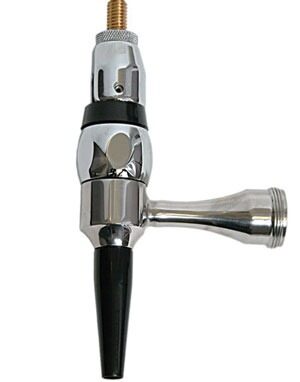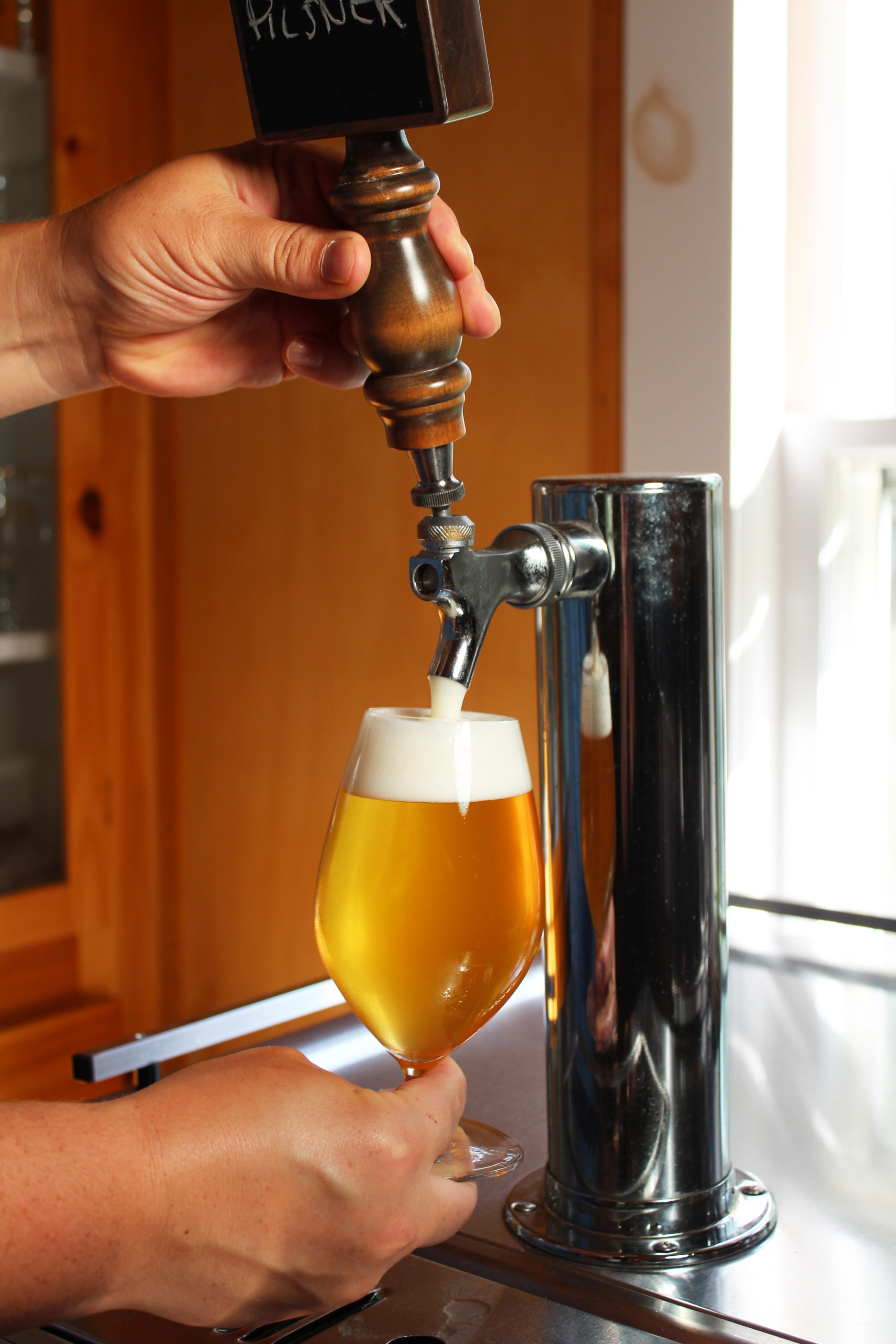Refurbishing and Cleaning Kegs
Used Cornelius style kegs are widely available at reasonable prices. A considerable amount of money can be saved if you buy kegs that have not been worked on in any way and rebuild them yourself. This process requires nothing but a little time, a limited amount of mechanical skills and most of the tools should be in every kegger’s tool kit. Recently, I rebuilt two used 5-gallon (19-L) Cornelius kegs. Used kegs are not in pristine condition on the outside, however they should be fine on the inside where it counts. They should only have been used for soda syrup, such as that for Pepsi or Coke. (Note that almost all soda fountains have switched to the bag-in-a-box setup. So, if you buy a used keg that still has syrup in it, it may have been there awhile.)
New, Used or Reconditioned?
For those who either do not have the time, or do not want to go to the trouble, new Corny kegs are available. New kegs usually cost more than $100, but they are shiny, dent-free and their rubber gaskets and O-rings don’t carry any off flavors or odors. Also, their poppet valves will not need to be replaced for some time. Reconditioned used kegs are also available, with typical prices starting around $35. When comparing prices between vendors, be sure to check on what has been done to the keg to recondition it. At a bare minimum, kegs should be pressure tested. Some sellers will also replace the O-rings and clean the keg. Others will additionally disassemble the keg, clean the dip tube and inspect and replace faulty poppet valves. In practical use, a fully reconditioned keg will work as well as a brand new one.
Coke or Pepsi, Pin Lock or Ball Lock
Corny kegs exist in two main styles, referring to the type of inlet and outlet connections on each type of keg: pin lock and ball lock. Pin lock kegs are ones that are used by Coca-Cola and are easily identified by the “pins” on the gas and liquid posts on the keg. Ball lock kegs are identified by the absence of pins on the gas and liquid posts and are used by the other soda companies. The “ball” name is derived from the ball bearings on the connectors that hold the connectors onto their respective posts. The advantages of one style of keg over the other are minimal and most homebrewers choose by their personal preference. Ball lock fittings and gadgets seem to be more readily available than those for pin lock kegs. Also, ball lock kegs are easily disassembled using regular sockets and wrenches — a special notched socket is needed to disassemble a pin lock keg. Pin lock kegs are slightly shorter than ball lock kegs which makes them more likely to fit in tight refrigerators. Regardless of which style of keg you choose, the parts for each type of keg are not interchangeable, thus a pin lock keg cannot be converted to a ball lock keg and vice versa. The connections and tools required vary by each manufacturer. For a pin lock keg, a 13⁄16” deep socket with special notches is needed (check your local or internet homebrew store or make one yourself). The gas in post is the one with two pins while the beer out post has three pins. For a ball lock keg, a combination wrench or deep socket will work for disassembly, in either 7⁄8” or 11⁄16” size depending on the keg manufacturer. The gas in post has notches on the hex base and can have either a 6 point or 12 point base. (Be sure to buy tools in the 12 point style, so that they will work on both types of fittings.) The beer out post has no notches along the 6 point hex base.
Cleaning the Outside
The outside of the keg can be cleaned using Bar Keeper’s Friend, an oxalic acid based cleanser that is not harmful to stainless steel. This cleaner can be purchased in most grocery stores and works well on all stainless steel brewing vessels. Use a soft nylon cleaning pad or sponge and follow the instructions on the can. Do not use steel wool or any other metallic cleaning pads. They will scratch the stainless steel, and sometimes embed small pieces of the steel in the surface, which will cause rust. The popular heavy duty Scotch-Brite pads (or “green scrubbies”) will also leave scratches in stainless steel. (The blue Scotch-Brite scrubbing pads and sponges — the ones that say “No Scratch” on the package — are fine.) Test your scrubbing pad on the outside of the keg first, before cleaning any surface that will contact beer. Cleaning the outside of the keg is optional, but I prefer all of my equipment to be clean. If you are going to clean the outside, I strongly suggest doing it before disassembly. I also suggest wearing latex or rubber gloves, as it is a dirty process. An alternative I have found, which is almost as good as using Bar Keeper’s Friend, is to soak the kegs overnight in a mixture of 1.0 oz. of PBW (Powdered Brewery Wash) per gallon (7.5 g/L) of hot water. At this same concentration, a PBW solution heated to 120–160 °F (49–71 °C) will clean almost any stainless surface, without scrubbing, in 30 minutes. If you are cleaning multiple kegs, a 100-qt. (95-L) picnic cooler holds enough liquid to submerge a Corny keg.
Disassembling the Keg
Before starting disassembly, relieve any pressure in the keg by either lifting the relief valve or depressing the poppet valve on the top of the post with a small tool. I have a small piece of wood dowel that I use, so I am sure not to damage the poppet. Be sure to put a rag or towel over the relief valve or post prior to relieving the pressure, as there will most likely be some syrup remaining in the keg. Once the pressure is relieved, remove the keg cover by lifting the latching lever, then lowering the cover into the opening and turning it slightly to align it. Remove and discard the lid O-ring. You will need a 3⁄8” drive ratchet wrench and either an 11⁄16” or 7⁄8” deep socket to remove the posts. I bought both sizes at Home Depot for less than $5 each. Since some posts are eight sided and others twelve sided, I would suggest buying twelve point sockets in both sizes. In the case of my kegs, which are Firestone Challenger VI, I needed the 7⁄8” for both posts. Unless you are certain what type of socket you need for your keg, it is a good idea to bring the posts, or the whole keg, with you when you go to the hardware store. On one side of each of the handles on top of the keg on the “gas in” side, it will have “in” markings. Take a good look at that post so you are sure to install it in the right place during re-assembly. At a quick glance, they look to be identical, but there are subtle differences, one of which is a small difference in size. Once the posts have been removed, I use a small jeweler’s type screwdriver to get the O-ring on the posts started, then slip a slightly larger screwdriver in beside it and pry the O-ring high enough to be able to slip it off the post. In my experience, this normally prevents damage to the O-ring. It is not critical at this time because you will replace all of the O-rings with new ones, but will be good practice. Discard the O-rings. Next, remove the dip tubes. You will notice the gas-in dip tube is short, and the liquid-out is long. The liquid-out tube is either straight or curved. Stick your hand through the opening and push up on each tube. They will usually slip out easily, but sometimes it requires a little effort. Once you have both dip tubes removed slip the O-rings off them and discard.
Cleaning Chemicals
It is now time to clean the inside. I like using PBW, however many homebrewers use the unscented version of OxiClean, whose active ingredients are sodium percarbonate and sodium carbonate. (The “oxi” in OxiClean refers to the fact that sodium percarbonate reacts with water to release hydrogen peroxide and sodium carbonate.) Other homebrew cleaners that contain sodium percarbonate include One-Step, B-Brite and Straight-A. PBW’s material safety data sheet (MSDS) lists only sodium metasilicate (30%), although their website also claims that it includes sodium carbonate. (It is also widely believed to contain sodium percarbonate.) Another common brewing cleaner is TSP (trisodium phosphate). Because of environmental concerns with the release of phosphate into the environment, many products sold as TSP actually contain up to 90% sodium carbonate.
Cleaning the Inside
Put the cover, posts and dip tubes in the keg. I put the keg in the basement shower and pour my cleaner into the keg, then fill it with household hot water. I like to run a tubing brush through the dip tubes a couple of times. Let the keg soak overnight, then give it, and the other parts, a thorough hot water rinse. Turn the keg upside down and let it drain and dry. Next, you will replace the O-rings you removed with new O-rings. You will need some food grade lubricant, such as Keg Lube, for this. Only a small film evenly spread on each O-ring is needed. First, lubricate and install the dip tube O-rings, and insert the dip tubes in the proper holes. Next, install the posts and tighten. Lubricate the post O-rings, and install them in the post grooves. Some homebrew shops sell colored O-rings for keg posts and I like to use a red one on the “gas in” post to identify it. Lubricate the large O-ring and fit it onto the lid. Install the lid and latch it. Reassemble the keg in opposite order of disassembly. Install the long diptube on the beer out side, matched with the proper 3 pin or un-notched post on top. The diptube should fit just above the indentation or well in the bottom of the keg. When reassembling the posts, be sure that the poppets are firmly in their posts — or at least secure enough that they don’t fall between the posts and the diptubes — while tightening. This will help you avoid damaging the feet of the poppets. When properly installed, the posts need little effort to tighten completely down. In some kegs, the long beer dip tube does not have a notch to hold it in place. As such, it may spin while you are tightening the post. Be sure to hold the diptube in place while tightening so that the diptube is not jammed up on one side of the keg. The small diptube for the gas in side installs similarly, but goes on the notched or two pin post. Finally, place the lid inside the keg and pull down on the lever making sure that the lid is seated directly in the middle of the lid opening and is not shifted to one side.
Testing for Pressure
Now that the keg is clean and rebuilt, it is time to check if it holds pressure. Connect the gas in disconnect to the gas in port and pressurize the keg to 12 PSI. That should be sufficient to seat the lid gasket. Use a small bowl and add a couple of teaspoons of dishwashing detergent to some tap water. Use a small (about 1 inch) paint brush, or a spray bottle, and liberally apply the detergent mixture to all of the gas fittings, connections and around the keg cover. If there are any leaks, you will see bubbles. If leaks are found, check the connections to make sure they are tight. When there are no leaks, pressurize the keg again to 12 PSI, and let it sit for a day. Use a pressure gauge attached to the “gas in” connector to monitor the pressure. (Some homebrew shops sell these, or build the spunding valve on page 61.) If the keg maintained pressure, it is refurbished and you are ready to go.
Maintaining the Keg
Once your keg is in good shape, it is quite easy to maintain. Each time you disassemble the keg for thorough cleaning, inspect each of the parts. Replace any O-rings that are cut or dry-rotted to be sure that a proper seal can be maintained. If, when assembling the keg, one of the posts will not hold a seal where the poppet seals against the post, first be sure that the post is properly tightened. If the poppet still won’t seal, attempt to reseat the poppet by pressing the poppet down with a screwdriver or other firm object. Use a paper towel to protect yourself from the spray if there is liquid in the keg. If it still won’t seal, then it’s time to change that poppet. (It’s likely the rubber O-ring at the head of the poppet is damaged, one of the feet are damaged, or the spring has worn to the point that it will not expand enough). Many homebrew shops carry a range of poppets for each of the different keg manufacturers. Be sure to check the manufacturer of the keg so that you can choose the proper poppet. Alternately, bring the old poppet with you for comparison when you get your new one. During use, sometimes it can be increasingly difficult to fit one of the connectors onto the post. When this happens, be sure you are using the proper connector for the post. If it is still difficult (or even impossible) to fit the connector over the post, wet the O-ring with water or apply a tiny amount of Keg Lube or other lubricant meant for beer fittings. The O-ring on the outside of the post may need to be changed if it is damaged or dry-rotted. If a new O-ring doesn’t solve the problem, then the post or connector is damaged and will need to be replaced. Be sure to check the manufacturer of the keg so that you can choose the proper post and poppet combination.
Cleaning and Sanitizing
Cleaning and sanitizing a well-maintained keg is critical to protect the beer from contamination, which can cause a myriad of off-flavors. Performing a cleaning step each time before sanitizing is highly recommended. Cleaning and sanitizing the keg follows the same basic procedure as refurbishing the keg. However, routine cleaning should be much easier as there is less soil to remove and you will not need to replace any O-rings or poppets unless they have worn out. To clean the keg, completely disassemble it and soak in a cleaning solution. Five Star PBW is a popular choice amongst homebrewers and works well. After filling the keg with cleaning solution, use the keg to hold all of the other parts including the O-rings. After cleaning, be sure to rinse the keg and all parts well. The keg can be cleaned while assembled, but it is not recommended since cleaners are generally hard to rinse and large yeast or hop deposits can get trapped in the springs of the poppets and can be difficult or impossible to clean without disassembling the posts. After cleaning, sanitize the keg using a good, no-rinse sanitizer such as Iodophor or Star San. This can be done while the keg is unassembled or assembled. To sanitize unassembled, just soak each part in the sanitizer in the keg just as was done for cleaning. For sanitizing assembled, assemble the keg, fill with sanitizing solution, and soak. Be sure to press down on each poppet after filling the keg with solution so that each dip tube will release the trapped air and fill with sanitizing solution. If you sanitized the keg assembled, top off the keg if necessary, fit the lid, and push the sanitizing solution out with CO2. The keg is now full of CO2, with little or no oxygen pre-sent, and ready to be filled.







